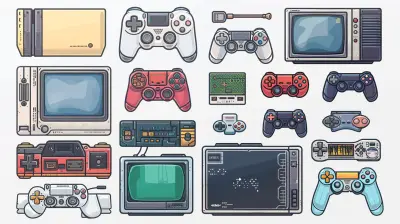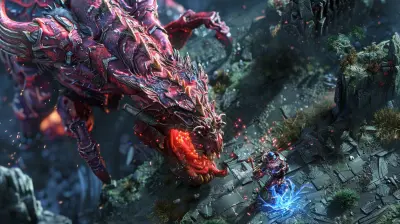Adaptive Strategies: Changing Your Approach Mid-Match
3 November 2025
Ever find yourself in a tight spot during a game, where your tried-and-tested strategy suddenly stops working? Frustrating, isn’t it? You start to wonder, “What’s going wrong?” The truth is, you’re battling more than just your opponents; you're up against a dynamic environment where adaptability is critical. This is the core idea behind adaptive strategies—pivoting mid-match to snatch victory from the jaws of defeat.
Gaming, much like life, rarely goes according to plan. It’s all about adapting to the unexpected, and those who can shift their tactics on the fly often come out on top. So, grab your controller, mouse, or phone, and let’s dive into the art of adaptive strategies.

Why Static Strategies Fall Apart
Think about it. Would you play the same way in a 5v5 shooter when your team is dominating compared to when you’re getting steamrolled? Probably not. Yet, many of us fall victim to what’s called "strategy stagnation." You develop a game plan that worked once—or maybe multiple times—and you stubbornly stick with it, thinking, “It’ll work again.” Spoiler: it often doesn’t.The reason is simple. Whether you're in a MOBA, a battle royale, or even a sports simulation game, your opponents are observing you just as much as you’re watching them. The longer a match goes on, the better they understand your tactics. If you don’t adapt, you’re feeding them an all-you-can-counter buffet.
But don’t worry—there’s light at the end of the tunnel. With a little awareness and effort, you can break free from rigid strategies and embrace a flexible, adaptive mindset. 
The Power of Flexibility in Gaming
Think of your strategy as a GPS. You have a destination in mind (winning!), but if roads are closed or traffic piles up, you need to reroute. Adaptive strategies are like alternate routes—they’re not necessarily Plan B; they’re part of a dynamic Plan A.For example, in a game like League of Legends, you might start the match as an aggressive laner, constantly pressuring your opponent under their tower. But what happens when the enemy jungler camps your lane? If you keep playing aggressively, you’re setting yourself up for disaster. Adaptive players know when to swap lanes, build defensive items, or even pivot to a supporting role for their team.
The same principle applies across game genres:
- Shooters (FPS): Switch between aggressive rushing and cautious camping based on enemy behavior.
- Card Games: Swap from a control strategy to aggressive combos depending on your opponent’s deck.
- Sports Games: Change formations or playstyles if your current approach isn’t breaking through their defense. 
How to Spot the Need for Change
Okay, so when do you know it’s time to abandon your current strategy? Simple: the moment things stop working consistently.Let’s break this down with some signs:
1. You’re Predictable
If your opponent is always three steps ahead, chances are they’ve figured you out. For instance, in a game like Overwatch, if every flanking attempt gets shut down, it’s time to reconsider your approach.2. Your Resources Aren’t Effective
Whether it’s in-game currency, health, or cooldowns, wasting resources is a huge red flag. Players who cling to ineffective strategies often burn through their options without meaningful gains.3. Team Dynamics Are Out of Sync
In team-based games, sticking to one role or tactic can create friction. If your team is struggling, your rigidity might be adding fuel to the fire.4. Momentum Shifts
If you start strong but lose steam mid-game, it’s often a sign your opponents have adapted to you. The only way to regain momentum is to adapt yourself.
Practical Steps to Adapt Mid-Match
So, how do you actually change your strategy mid-match? Let’s break it into actionable steps.1. Pause and Assess the Situation
Adapting starts with awareness. Take a moment—literally a couple of seconds—to analyze what’s going on.- Are you falling behind in resources?
- Is the enemy exploiting a specific weakness?
- What’s your team’s current dynamic?
Gaming is fast-paced, but even a brief pause can give you valuable insights. Think of it as a quick timeout in sports to regroup and re-strategize.
2. Switch Gears on Playstyle
Your playstyle is your core tool for adaptation. Are you playing too passively? Too aggressively? Maybe it’s time to try something unconventional.For example:
- In an FPS, if your sniping isn’t working, switch to a shotgun and go close-range.
- In a MOBA, stop going for solo kills and focus on helping your teammates secure objectives instead.
3. Leverage Your Opponent’s Weaknesses
Adapting isn’t just about addressing your own flaws; it’s also about exploiting theirs. If you notice an enemy habit—like always retreating to the same cover or repeatedly spamming the same combo—use it against them.This makes adaptation proactive rather than reactive. You’re not just plugging holes; you’re creating opportunities.
4. Communicate with Your Team
If you’re playing a team-based game, adaptability isn’t a solo mission. Share observations with your teammates. A simple callout like, “Hey, they’re targeting me, let’s switch roles,” can flip the script on even the toughest matches.5. Experiment on the Fly
Don’t be afraid to try risky or unconventional tactics. Sure, they might not always work, but staying unpredictable forces your opponents to stay on their toes. Sometimes, the element of surprise is all you need to break out of a losing streak.Building an Adaptable Mindset Outside the Game
Adaptability in gaming isn’t just about quick reactions; it’s a mindset you can develop over time. Here are some ways to foster this skill:1. Embrace Failure
Let’s be real: nobody’s perfect. You’re going to lose matches, and that’s okay. Instead of blaming the game, your teammates, or RNG, focus on what you could have done differently.Failure is like a coach—it teaches you what doesn’t work so you can narrow down what does.
2. Diversify Your Playstyle
If you always rely on one type of character, weapon, or strategy, you’re limiting yourself. Experiment with different options in casual matches to build a wider skill set. The more tools you have in your arsenal, the easier it is to adapt when needed.3. Watch and Learn
Whether it’s Twitch streams, YouTube tutorials, or spectating skilled players, there’s always something new to learn. Pay attention to how top players adapt during matches—it’s like getting a free class on advanced tactics.4. Practice Mental Flexibility
Adaptability isn’t just a mechanical skill; it’s mental. Challenge yourself to think creatively during matches. Ask, “What’s one thing I haven’t tried yet?” Over time, this will become second nature.The Reward of Adapting
Here’s the kicker: when you change your strategy mid-match and succeed, it feels incredible. It’s not just about winning; it’s about proving to yourself that you can handle the unexpected.Imagine being behind in a battle royale, low on health, pinned down by snipers, and then pulling off a brilliant flank to secure the win. That’s the magic of adaptability—it turns impossible situations into personal triumphs.
Final Thoughts
Gaming is all about challenges, and no two matches are ever the same. By developing adaptive strategies, you’re not just improving your odds of winning; you’re growing as a player. So next time your go-to plan starts crumbling, don’t panic. Take a deep breath, reassess, and pivot. Who knows? That mid-match change might just be your ticket to victory.all images in this post were generated using AI tools
Category:
Game StrategiesAuthor:

Jack McKinstry
Discussion
rate this article
1 comments
Orion Weber
Like a chameleon at a chess tournament—embrace the unexpected, outsmart your foes!
November 4, 2025 at 4:58 PM

Jack McKinstry
Absolutely! Adapting like a chameleon is key to staying unpredictable and gaining the upper hand.


